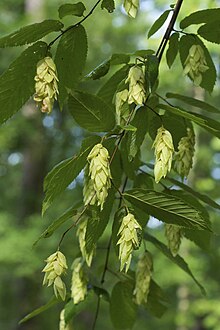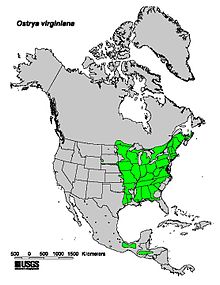Ostrya virginiana
| American hophornbeam | |
|---|---|
 |
|
| A hophornbeam branch with the characteristic hops, in early summer | |
| Scientific classification | |
| Kingdom: | Plantae |
| Clade: | Angiosperms |
| Clade: | Eudicots |
| Clade: | Rosids |
| Order: | Fagales |
| Family: | Betulaceae |
| Genus: | Ostrya |
| Species: | O. virginiana |
| Binomial name | |
|
Ostrya virginiana (Mill.) K.Koch |
|
 |
|
| Generalized native range | |
| Synonyms | |
|
|
Ostrya virginiana, the American hophornbeam, is a species of Ostrya native to eastern North America, from Nova Scotia west to southern Manitoba and eastern Wyoming, southeast to northern Florida and southwest to eastern Texas. Populations from Mexico and Central America are also regarded as the same species, although some authors prefer to separate them as a distinct species, Ostrya guatemalensis. Other names include eastern hophornbeam, hardhack or hackmatack (in New England), ironwood, and leverwood. In Windsor County, Vermont, the tree has been called remen for generations. The origins of this name are unknown, likely confusion with a tree in Britain known to the colonists.
American hophornbeam is a small deciduous understory tree growing to 18 m (59 ft) tall and 20–50 centimetres (8–20 in) trunk diameter. The bark is brown to gray-brown, with narrow shaggy plates flaking off, while younger twigs and branches are smoother and gray, with small lenticels. Very young twigs are sparsely fuzzy to thickly hairy; the hairs (trichomes) drop off by the next year.
The leaves are ovoid-acute, 5–13 cm (2–5 in) long and 4–6 cm (1 1⁄2–2 1⁄4 in) broad, pinnately veined, with an doubly serrated margin. The upper surface is mostly hairless, while the lower surface is sparsely to moderately fuzzy (rarely densely hairy).
...
Wikipedia

